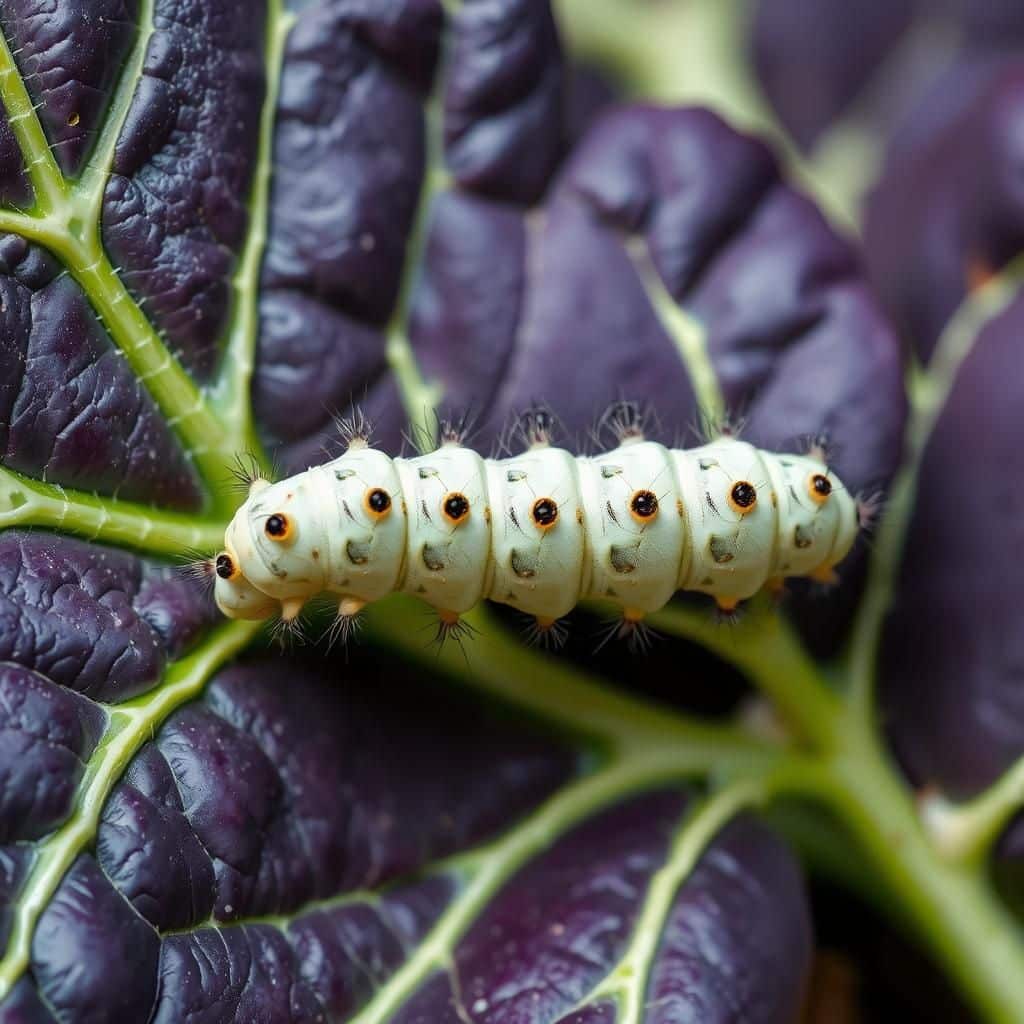Essential Guide to Cabbage White Caterpillar Food: Best Plants and Tips for Care

Cabbage white caterpillars, the larvae of the cabbage white butterfly, are common garden pests that can wreak havoc on your crops. Understanding their dietary preferences is crucial for effective pest management and ensuring healthy plants. This essential guide provides a comprehensive overview of the best plants to cultivate for cabbage white caterpillars, as well as practical tips for their care and control. Whether you’re an experienced gardener or a novice, this article will equip you with the knowledge needed to manage these caterpillars while maintaining a thriving garden ecosystem. Discover how to balance attraction and management for optimal results.
Cabbage White Caterpillar Food: A Guide to Their Diet
The cabbage white caterpillar, which is the larval stage of the cabbage white butterfly, primarily feeds on plants from the Brassicaceae family, commonly known as cruciferous vegetables. These include cabbage, broccoli, kale, and cauliflower. The caterpillars are known for their voracious appetite, which can lead to significant damage in gardens and agricultural fields if left unchecked. Understanding their feeding habits is crucial for gardeners and farmers aiming to protect their crops from these pests. The cabbage white caterpillar has a preference for young, tender leaves, making early-season crops especially susceptible to infestations.
Preferred Plants for Feeding
The cabbage white caterpillar shows a clear preference for certain plants, particularly those in the Brassica family. Popular choices include cabbage, Brussels sprouts, kale, and rapeseed. They can sometimes also be found on other vegetables and weeds, but their primary target is the young leaves of Brassicaceae plants. These caterpillars are particularly drawn to lush and healthy foliage, which provides the necessary nutrients for their growth and development.
Impact on Gardens
The presence of cabbage white caterpillars in a garden can have a notable impact on crop yields. They consume large amounts of plant material, often leaving behind skeletonized leaves that can reduce the overall health of the plants. Infestations can particularly harm young plants which are more vulnerable to damage. Gardeners need to be vigilant and monitor their crops regularly to manage these pests effectively before they cause extensive harm.
Control Methods
Several effective control methods exist to manage cabbage white caterpillars in a garden setting. These include manual removal of the caterpillars, the use of floating row covers to protect vulnerable plants, and introducing natural predators such as birds and parasitic wasps. Organic insecticides derived from neem oil or Bacillus thuringiensis (Bt) can also be employed as a tactical measure to keep caterpillar populations in check without harming beneficial insects.
See also:
Nutritional Needs
The nutritional needs of cabbage white caterpillars guide their feeding behavior and are essential for their growth. High nitrogen content is particularly beneficial, which is why they seek out younger leaves rich in nutrients. This feeding behavior helps them accumulate energy for their transformation into butterflies. As they grow, their food intake increases significantly, which also raises the risks of them damaging crops before reaching maturity.
Life Cycle Stages Affecting Food Intake
The life cycle stages of the cabbage white caterpillar influence their food intake dramatically. In their early instar stages, they consume less but tend to focus intensively on soft leaves. As they progress to later instars, their appetite increases, demanding much more food for rapid growth. This increased feeding can lead to greater damage to plants and tactics must be implemented to manage populations effectively during these critical growth stages.
| Stage | Food Preference | Damage Potential |
|---|---|---|
| First Instar | Younger leaves | Low |
| Second Instar | Soft foliage | Moderate |
| Third Instar | Tender leaves | High |
| Fourth Instar | Established plants | Very High |
Understanding the Dietary Needs of Cabbage White Caterpillars
Cabbage White Caterpillars, primarily the larvae of the Pieris rapae butterfly, have specific dietary requirements that are crucial for their growth and development. These caterpillars thrive on brassicaceous plants, including cabbage, kale, broccoli, and mustard greens. It is essential to provide an adequate food source with high nutritional value to ensure they grow healthy and successfully transition into adulthood. Additionally, keeping the plants free from pesticides is critical, as these chemicals can be harmful to the larvae. Creating a conducive environment, combining proper nutrition with good care practices, will ensure that the caterpillars develop successfully into beautiful butterflies.
Best Host Plants for Cabbage White Caterpillars
The best host plants for Cabbage White Caterpillars are part of the Brassicaceae family, which includes various species like cabbage, cauliflower, and collard greens. These plants are highly favored by the larvae since they provide the necessary nutrients for growth. Cultivating these plants not only supports the caterpillars but also helps in sustaining the biodiversity of local ecosystems, as these species attract other beneficial insects.
Tips for Cultivating Cabbage and Other Brassicas
To successfully cultivate cabbage and other brassicas, ensure that they are planted in well-drained soil with adequate sunlight. Regular watering is crucial; however, avoiding waterlogged conditions is essential to prevent root rot. It's beneficial to utilize organic fertilizers to promote healthy growth, providing the vital nutrients required for the development of both the plants and the caterpillars that feed on them.
See also:
Natural Pest Management Strategies
Implementing natural pest management strategies is essential in caring for both the plants and the Cabbage White Caterpillars, as chemical pesticides can disrupt their growth. Utilizing companion planting with herbs like basil or mint can deter other pests while providing a suitable habitat for caterpillars. Additionally, introducing beneficial insects such as ladybugs can help control aphid populations, ensuring a balanced ecosystem that supports the caterpillars.
Encouraging a Biodiverse Garden Environment
Creating a biodiverse garden environment is essential for the thriving of Cabbage White Caterpillars. Incorporating a variety of plants not only provides ample food sources but also attracts pollinators and other beneficial insects that contribute to a healthy garden ecosystem. This biodiversity helps maintain ecological balance, making it less likely for harmful pests to establish themselves, thus supporting the caterpillar population.
When to Harvest Cabbage for Optimal Caterpillar Food
Timing is vital when harvesting cabbage and other plants as caterpillar food. It’s generally best to leave some plants in the garden for the caterpillars to feed on before harvesting them later for consumption. Monitoring the growth of the caterpillars and ensuring they have enough food until they pupate can help maintain a healthy cycle of butterfly emergence, benefiting both the gardener and the caterpillars in the long run.
Questions from Our Readers
What do cabbage white caterpillars eat?
Cabbage white caterpillars primarily feed on cruciferous vegetables, such as cabbage, broccoli, cauliflower, and kale. These caterpillars are particularly attracted to the leaves of these plants, where they can consume large amounts of foliage to fuel their growth.
How do I identify cabbage white caterpillars?
Cabbage white caterpillars can be identified by their green color, which often blends in with the leaves of their host plants. They are typically covered in fine hairs and have a distinctive cylindrical shape, making them recognizable among other caterpillar species.
See also:
Are cabbage white caterpillars harmful to plants?
Yes, cabbage white caterpillars can be quite harmful to crops, particularly those in the Brassica family. Their feeding habits can lead to defoliation, reduced yield, and even the death of the plant if infestations are severe.
How can I control cabbage white caterpillars in my garden?
Controlling cabbage white caterpillars can be achieved through several methods, including manual removal, using floating row covers, or applying organic insecticides like Bt (Bacillus thuringiensis) which specifically target caterpillars without harming beneficial insects.

If you want to read more articles like Essential Guide to Cabbage White Caterpillar Food: Best Plants and Tips for Care, we recommend you check out our Gardeners category.
Leave a Reply
Related Articles